
- Subject:
- Calculus
- Mathematics
- Material Type:
- Unit of Study
- Provider:
- Ohio Open Ed Collaborative

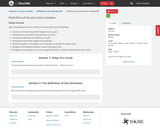
After completing this section, students should be able to do the following.Use limits to find the slope of the tangent line at a point.Understand the definition of the derivative at a point.Compute the derivative of a function at a point.Estimate the slope of the tangent line graphically.Write the equation of the tangent line to a graph of a function at a given point.Recognize and distinguish between secant and tangent lines.Recognize the the tangent line as a local approximation for a differentiable function near a point.

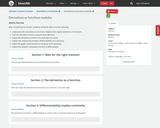
After completing this section, students should be able to do the following.Understand the derivative as a function related to the original definition of a function.Find the derivative function using the limit definition.Relate the derivative function to the derivative at a point.Explain the relationship between differentiability and continuity.Relate the graph of the function to the graph of its derivative.Determine whether a piecewise function is differentiable.

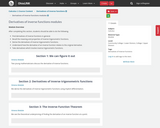
After completing this section, students should be able to do the following.Find derivatives of inverse functions in general.Recall the meaning and properties of inverse trigonometric functions.Derive the derivatives of inverse trigonometric functions.Understand how the derivative of an inverse function relates to the original derivative.Take derivatives which involve inverse trigonometric functions.

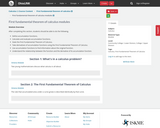
After completing this section, students should be able to do the following.Define accumulation functions.Calculate and evaluate accumulation functions.State the First Fundamental Theorem of Calculus.Take derivatives of accumulation functions using the First Fundamental Theorem of Calculus.Use accumulation functions to find information about the original function.Understand the relationship between the function and the derivative of its accumulation function.

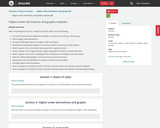
After completing this section, students should be able to do the following.Use the first derivative to determine whether a function is increasing or decreasing.Define higher order derivatives.Compare differing notations for higher order derivatives.Identify the relationships between the function and its first and second derivatives.Sketch a graph of the second derivative, given the original function.Sketch a graph of the original function, given the graph of its first or second derivative.Sketch a graph of a function satisfying certain constraints on its higher-order derivatives.State the relationship between concavity and the second derivative.Interpret the second derivative of a position function as acceleration.Calculate higher order derivatives.Given the graph of a position function, find time intervals where the velocity is positive/negativeGiven the graph of a position function, find time intervals where the velocity is increasing/decreasing

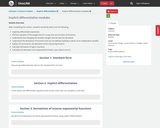
After completing this section, students should be able to do the following.Implicitly differentiate expression.Find the equation of the tangent line for curves that are not plots of functions.Understand how changing the variable changes how we take the derivative.Understand the derivatives of functions that are not defined explicitly in terms of an independent variable .Explain the formula for the derivative of the natural log function.Calculate derivatives of logs in any base.Calculate the derivative of an exponential function, axax, where a>0a>0.

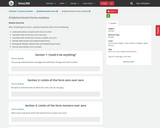
After completing this section, students should be able to do the following.Understand what is meant by the form of a limit.Calculate limits of the form zero over zero.Calculate limits of the form nonzero number over zero.Identify determinate and indeterminate forms.Distinguish between determinate and indeterminate forms.Discuss why infinity is not a number.


Introduction to differential equation modules


After completing this section, students should be able to do the following.Recall how to find limits for forms that are determinate.Define an indeterminate form.Determine if a form is indeterminate.Convert some indeterminate forms to the form zero over zero or infinity over infinity.Determine when can l’Hôpital’s Rule be used.Use l’Hôpital’s Rule to find limits.

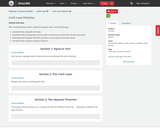
After completing this section, students should be able to do the following.Calculate limits using the limit laws.Calculate limits by replacing a function with a continuous function that has the same limit.Understand the Squeeze Theorem and how it can be used to find limit values.Calculate limits using the Squeeze Theorem.